Did you know a household of three throws away about 2,400 kilograms of waste each year? The EPA says so. This shows how important it is to live sustainably.
Choosing a zero-waste lifestyle is a big step towards saving our planet. By being mindful of our choices, we can cut down on waste. This not only helps the environment but also saves us money by reducing what we buy and throw away.
Key Takeaways
- Understand the impact of your household waste on the environment.
- Learn simple tips to adopt a zero-waste lifestyle.
- Discover how sustainable living can lead to financial savings.
- Explore practical ways to reduce your waste output.
- Implement sustainable practices in your daily life.
Understanding the Zero-Waste Movement
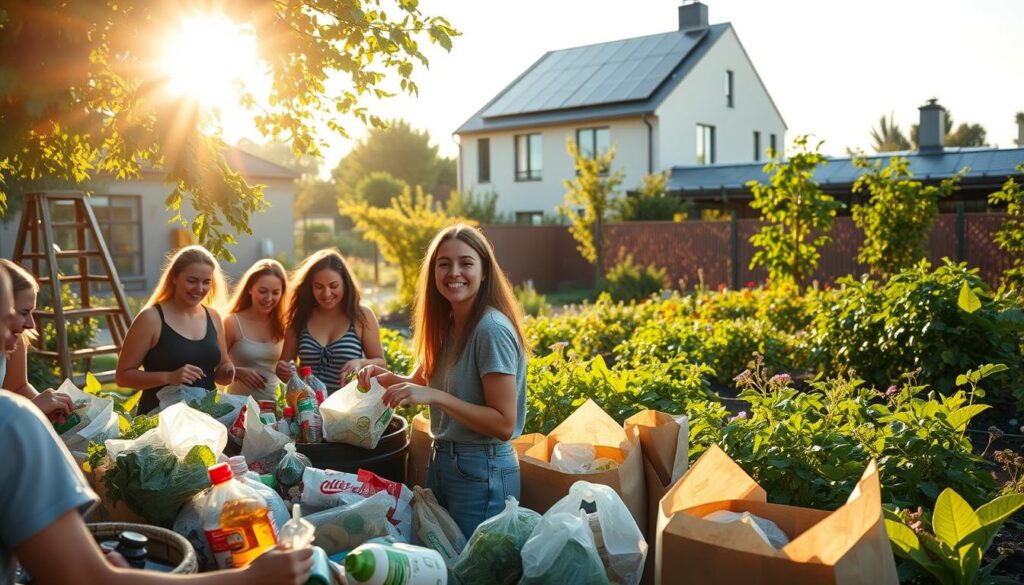
Learning about zero-waste living is key to helping our planet. The zero-waste movement is growing as people see how their daily choices affect the environment. A zero-waste lifestyle means making less waste go to landfills. It’s about using less, reusing what you can, and recycling. Bea Johnson, a zero-waste leader, said,
“The zero-waste lifestyle is a lifestyle that is in line with the natural world.”
This way of living asks you to think about what you buy and use more carefully. We all know waste harms our environment a lot. It causes pollution, climate change, and destroys habitats. Making waste means using lots of energy and resources. By making less waste, we can lessen these problems.
The 5 Rs: Refuse, Reduce, Reuse, Recycle, Rot
The 5 Rs are key to living zero-waste. They help you:
- Refuse things you don’t need
- Reduce how much you buy
- Reuse items when you can
- Recycle things that can’t be reused
- Rot (compost) food waste
By following the 5 Rs, you can greatly reduce your impact on the environment. This helps make a better future for all of us.
Financial Benefits
A zero-waste lifestyle is good for the planet and your wallet. It helps you save money and protect the environment. By choosing sustainable options, you can cut down on daily costs.
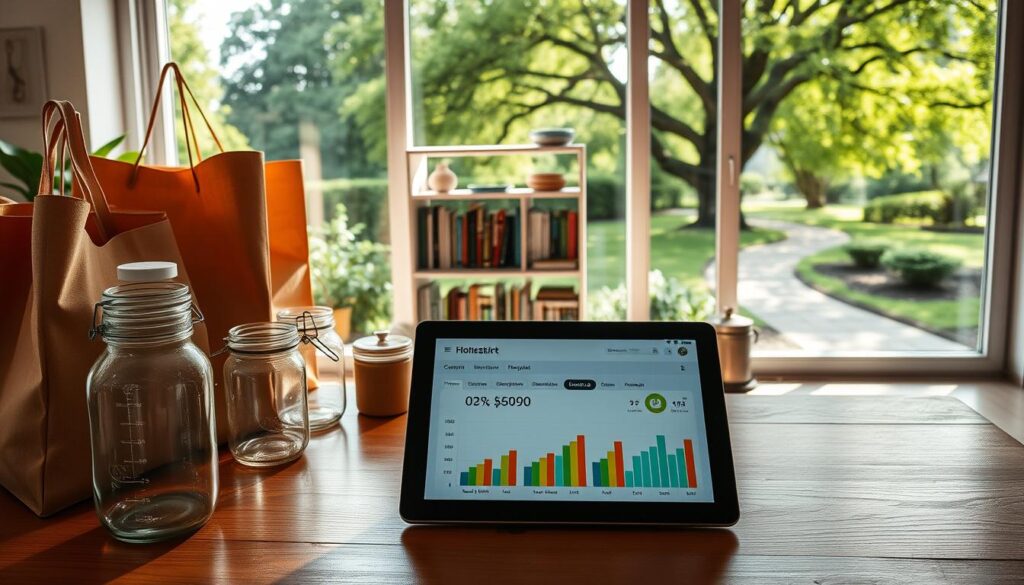
How Zero-Waste Living Reduces Daily Expenses
Zero-waste living cuts down on daily costs by avoiding single-use items. Using reusable items like cloth bags and stainless steel bottles saves money. You won’t need to buy disposable products as often.
Mindful consumption is also key. Being aware of what you buy helps you avoid unnecessary purchases. This reduces waste and saves you money.
Long-Term Financial Gains of Sustainable Choices
Sustainable choices can save you money in the long run. For example, energy-efficient appliances cost more upfront but save on bills later. They’re a smart investment for your wallet.
Choosing durable products over cheap ones also saves money. You won’t need to replace them as often. This approach is cost-effective and eco-friendly.
Breaking the Cycle of Consumerism
To live zero-waste, you must break the cycle of consumerism. This means adopting mindful purchasing habits and valuing quality over quantity.
Mindful Purchasing Habits
Being mindful of your purchases is essential. Think about a product’s necessity, durability, and environmental impact before buying. This helps you avoid impulse buys and waste.
Quality Over Quantity Approach
Investing in fewer, better-quality items is wise. This approach reduces waste and saves money by cutting down on replacements. It’s a smart way to shop.
By following these tips, you can enjoy the financial perks of a zero-waste lifestyle. Plus, you’ll help make the world a greener place.

Essential Zero-Waste Swaps That Save Money
Starting a zero-waste lifestyle is easy and can save you money. Just a few simple changes can make a big difference. You’ll cut down on waste and save cash too.
Kitchen Essentials: Reusable Containers and Cloth Bags
Begin by ditching single-use plastics in your kitchen. Reusable containers and cloth bags are better for the planet and last longer. For example, using beeswax wraps instead of plastic wrap saves money and reduces waste.
Bathroom Alternatives: Plastic-Free Toiletries
In the bathroom, you can also make big changes. Try plastic-free toiletries like bamboo toothbrushes and safety razors. They’re good for the environment and can save you money over time.
On-the-Go Items: Water Bottles and Coffee Cups
For those always on the move, get a reusable water bottle and coffee cup. They cut down on plastic waste and save you money. No more buying disposable cups and bottles.
Initial Investment vs. Long-Term Savings
Some zero-waste swaps might cost more at first, but they save you money in the long run. Let’s look at the numbers.
Cost Breakdown Analysis
A reusable water bottle costs $10 but saves you $5 a week. That’s $260 a year in savings.
Payback Period for Common Swaps
Figuring out the payback period helps you see when you’ll get your money back. For example, a $15 coffee cup saves you $3 a week. It pays for itself in 5 weeks.
By making these zero-waste changes, you help the planet and save money. Start with the biggest impact and watch your savings grow.

Zero-Waste Grocery Shopping Strategies
Adopting zero-waste grocery shopping can greatly reduce your environmental impact. Simple changes in your shopping habits can help create a more sustainable future.
Bulk Buying Techniques and Store Recommendations
Buying in bulk is key to zero-waste shopping. It cuts down on packaging waste and can save you money. Look for stores with bulk bins for items like nuts, grains, and dried fruits. Bulk Apothecary and Thrive Market are great places to start.
Make sure you have the right storage for your bulk items. This keeps them fresh for longer.
Farmers Markets and Local Sourcing Benefits
Shopping at farmers markets supports local farmers and cuts down on transportation emissions. You’ll find fresh, seasonal produce with little packaging. Local Harvest helps you find markets near you.
Meal Planning to Reduce Food Waste and Expenses
Meal planning is vital to cut down on food waste. It helps you make a precise grocery list, avoiding unnecessary purchases. Here are some meal planning tips:
- Plan meals around seasonal and sale items.
- Use a meal planning app for recipes and lists.
- Cook meals that use similar ingredients to reduce waste.
Packaging-Free Shopping Tips
To shop without packaging, use reusable bags, containers, and produce bags. Many stores now offer package-free options or let you bring your own containers. Some even give discounts for reusable bags.
Make it a habit to carry these items with you. It helps cut down on packaging waste.

Save Money While Saving the Planet
Making your own DIY zero-waste products is a simple way to reduce waste and save money. By creating your own cleaning products, personal care items, and upcycling old materials, you can significantly cut down on packaging waste and lower your expenses.
Homemade Cleaning Products with Simple Ingredients
Switching to homemade cleaning products is a great first step. They are better for the environment, gentler on surfaces, and save you money.
All-Purpose Cleaners
An all-purpose cleaner can be made with just a few ingredients: water, white vinegar, and a few drops of your favourite essential oil. This mixture is effective, non-toxic, and costs just pennies compared to store-bought cleaners.
Laundry Solutions
For laundry, you can make your own detergent using washing soda, borax, and soap. This DIY detergent is free from harsh chemicals found in many commercial products and is gentler on clothes.
DIY Personal Care Items: Deodorant, Toothpaste, and More
Personal care items are another area where you can easily make your own products. Making deodorant, toothpaste, and other personal care products at home reduces packaging waste and allows you to control the ingredients.
Upcycling Projects for Home and Garden
Upcycling is a creative way to give new life to old items. You can turn old jars into planters, create garden markers from recycled materials, and make decorative items for your home.
Cost Comparison: Store-Bought vs. Homemade
When comparing the costs, homemade products are generally cheaper. For example, making your own all-purpose cleaner can cost as little as $0.50 per litter, compared to $2-$3 for a store-bought version. The savings add up over time, making DIY zero-waste products a financially savvy choice.
By embracing DIY zero-waste products, you’re not only contributing to a more sustainable lifestyle but also enjoying the financial benefits that come with it. Start with simple projects and gradually move to more complex ones, and you’ll be surprised at how much you can save and the positive impact you can have on the environment.
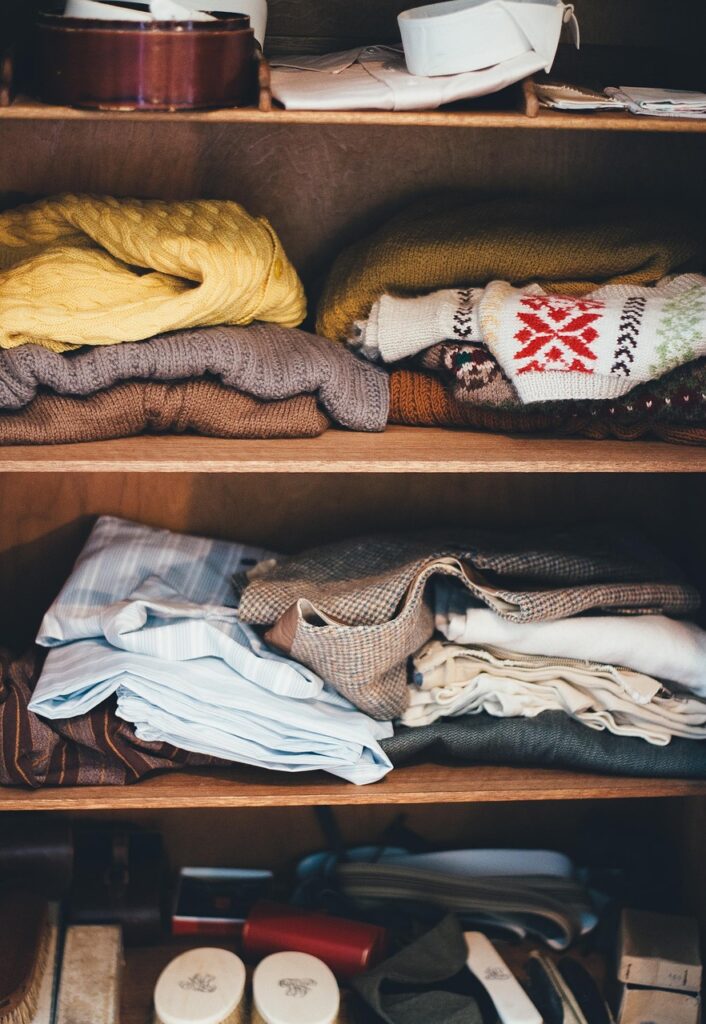
Minimizing Waste in Your Wardrobe
Creating a zero-waste wardrobe means thinking carefully about what you buy. The fashion world produces a lot of waste. But, by choosing quality basics, shopping second-hand, and fixing clothes, you can help reduce this problem.
Building a Capsule Wardrobe: Quality Basics
A capsule wardrobe focuses on quality basics that you can wear in many ways. This method cuts down on waste and makes getting ready easier. First, figure out your style and the colours you like best.
Second-Hand Shopping Tips and Best Platforms
Shopping second-hand is a smart way to update your clothes without adding to waste. Look for high-quality, gently used items on sites like ThredUp, Poshmark, or at local thrift stores.
Clothing Repair and Maintenance Skills
Knowing how to fix your clothes can make them last longer. Simple fixes like sewing on buttons or patching tears can help a lot. You can find tutorials online or take a sewing class locally.
Ethical Fashion on a Budget
Eco-friendly fashion doesn’t have to cost a lot. Look for brands that care about the planet and fair work. Buy during sales or use coupons. Supporting local designers or artisans is also a good choice.
By using these tips, you can greatly reduce waste in your closet. This helps make the fashion world more sustainable.
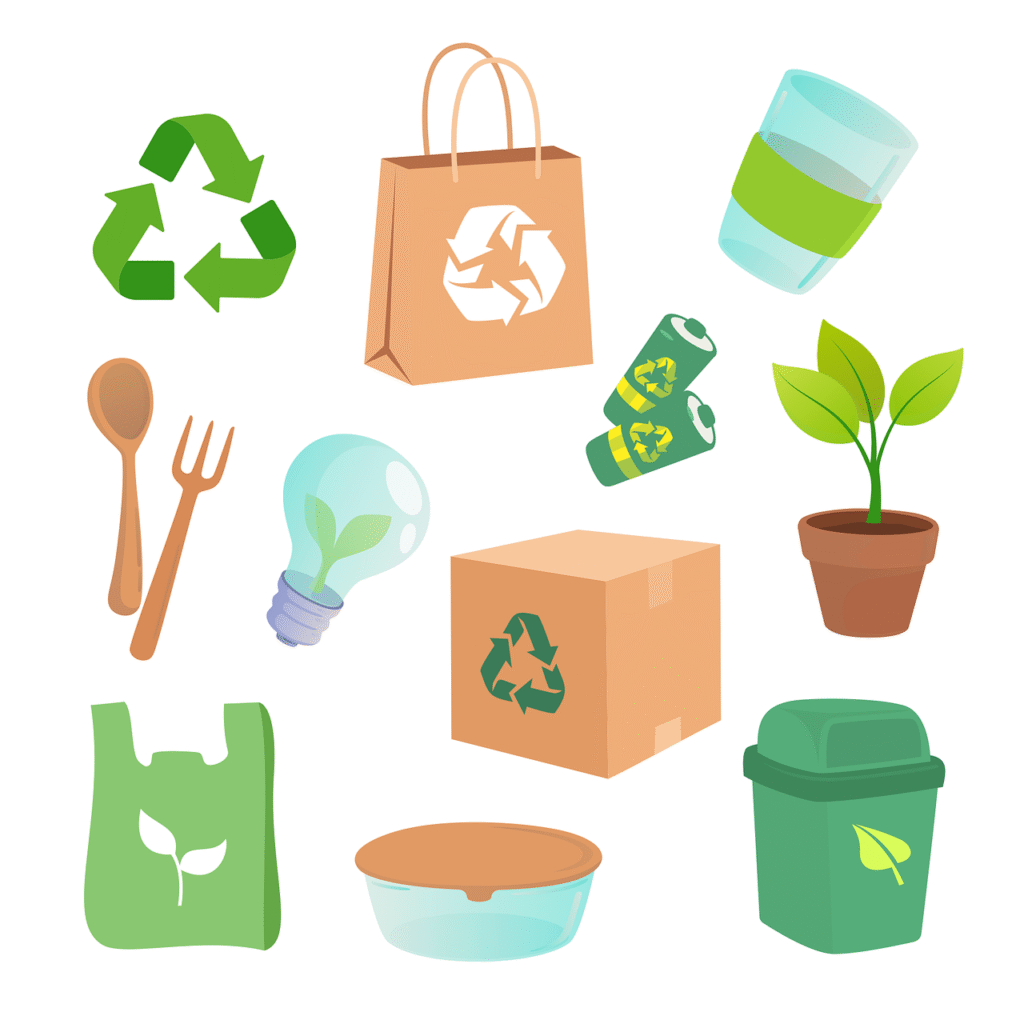
Zero-Waste Home Management
Creating a zero-waste home is easy with a few simple steps. Start by saving energy and water, go paperless, and compost. These actions can cut down your household waste a lot.
Energy and Water Conservation Techniques
It’s key to save energy and water at home. Simple steps like using LED bulbs and turning off unused appliances help a lot. Also, fix leaks and use energy-saving appliances and low-flow showerheads to cut down on use.
Paperless Systems and Digital Solutions
Going paperless is a big step towards zero waste. Start by switching to digital documents and bills. Use apps and digital tools for notes and organization to use less paper. This helps the planet and keeps your home tidy.
Composting and Food Waste Management
Composting is a great way to handle food waste. It turns organic stuff into soil that’s good for plants. There are many ways to compost, depending on where you live.
Apartment-Friendly Composting
If you live in an apartment, you can compost indoors. Use bins or vermicomposting with worms. These methods are clean and work well in small spaces.
Garden Composting Systems
For gardeners, outdoor composting is a good option. You can use bins or piles for kitchen and yard waste. Make sure to turn it often and keep it moist for best results.
Sustainable Cleaning Routines
Using eco-friendly cleaning methods is also important. Make your own cleaners with things like baking soda and vinegar. This cuts down on chemical waste and packaging.
By making these changes, you can make your home more sustainable. Every small step helps the planet a lot.
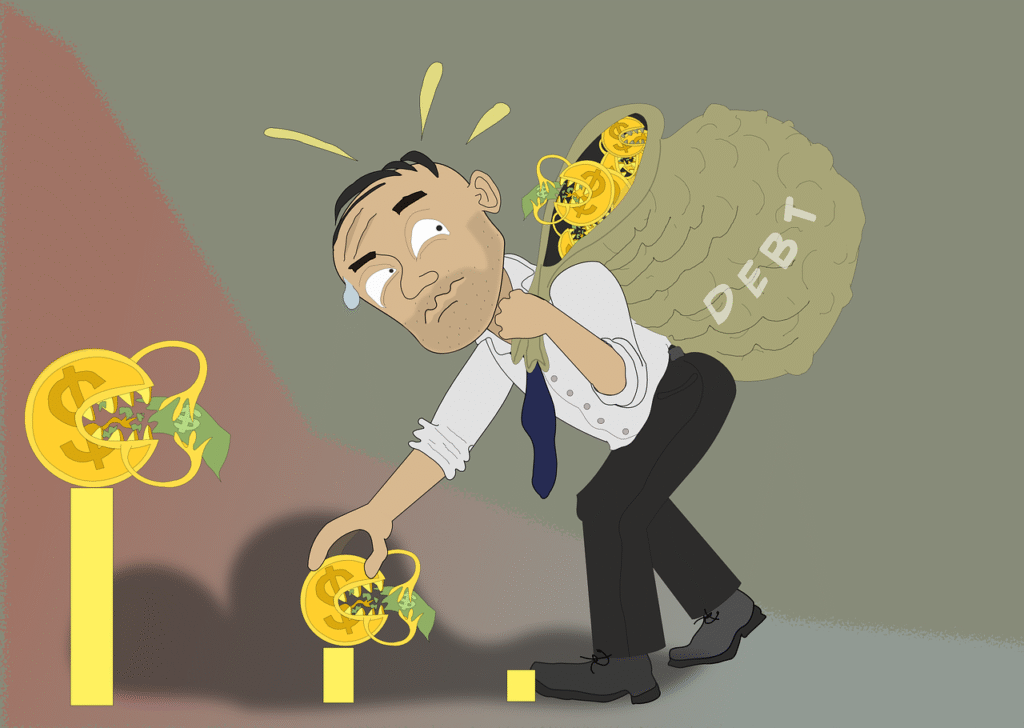
Zero-Waste Living on a Budget
You don’t have to spend a lot to live sustainably. Zero-waste living can be affordable. Many think it costs a lot upfront, but it doesn’t have to. With smart strategies, you can cut waste and save money.
Addressing Common Obstacles and Misconceptions
Many think zero-waste living is pricey. But, it can actually save you money. For example, buying in bulk and avoiding single-use packaging can lower your grocery bills.
Common obstacles to zero-waste living include:
- Lack of knowledge about zero-waste practices
- Perceived high cost of eco-friendly products
- Limited access to bulk stores or zero-waste resources
Gradual Transitions vs. Complete Overhauls
You don’t have to change everything at once. Making small changes can be easier and more effective. Start with simple swaps, like reusable bags or water bottles.
A gradual approach allows you to:
- Assess your current habits and identify areas for improvement
- Make incremental changes that fit your budget
- Monitor your progress and adjust as needed
Community Resources and Support Systems
Connecting with others and using community resources helps a lot. Look for local groups, online forums, and social media for tips and support.
“The power of community is key to successful zero-waste living. By sharing knowledge and resources, we can support each other in making sustainable choices.” – Zero-Waste Advocate
Balancing Sustainability with Financial Constraints
It’s important to plan and be creative when balancing sustainability and money. Focus on changes that have a big impact on the environment but are affordable.
By making smart choices and using community resources, you can live zero-waste on a budget. This helps create a more sustainable future.

Conclusion: Your Journey Toward a Sustainable Future
Starting your zero-waste journey is a big step towards a better future. Every little action you take helps. By following the 5 Rs – Refuse, Reduce, Reuse, Recycle, Rot – you can lessen your impact on the planet.
Choosing a zero-waste lifestyle is more than saving money or cutting down on waste. It’s about living in a way that’s better for our planet. Using reusable items, buying in bulk, and making your own cleaning products are all steps in the right direction.
As you keep moving forward, you’ll help make the world a greener place. Your actions will encourage others to join in. Together, we can make a big difference. Keep going, and you’ll help create a better world for all of us.
FAQ
What is a zero-waste lifestyle, and how can it benefit me?
A zero-waste lifestyle means making less waste to help the environment. It can save you money and help the planet. It’s a way to live more sustainably.
How do the 5 Rs contribute to a zero-waste lifestyle?
The 5 Rs – Refuse, Reduce, Reuse, Recycle, Rot – are key to zero-waste living. They help you cut down on waste and live greener.
Can a zero-waste lifestyle really save me money?
Yes, it can. By spending less and choosing wisely, you can save money. It’s a smart way to live.
What are some essential zero-waste swaps I can make to save money?
Switch to reusable items like containers and bags. Use plastic-free toiletries and refillable bottles. These changes can save you money and reduce waste.
How can I implement zero-waste grocery shopping strategies?
Buy in bulk and shop at farmers markets. Plan meals to avoid waste. Choose products without packaging. These steps help reduce waste and save money.
What are the benefits of DIY zero-waste products?
DIY products cut down on waste and save money. They’re also better for the planet. It’s a smart, eco-friendly choice.
How can I minimize waste in my wardrobe?
Build a capsule wardrobe and shop second-hand. Fix clothes instead of throwing them away. Make choices that are good for the planet and your wallet.
What are some strategies for zero-waste home management?
Save energy and water, and go paperless. Compost and clean sustainably. These steps make your home greener and cheaper to run.
How can I overcome common challenges and misconceptions about zero-waste living on a budget?
Start small and find support. Balance your budget with eco-friendly choices. It’s doable and beneficial for the planet.
Is zero-waste living on a budget feasible?
Yes, it is. Small changes can make a big difference. You can live sustainably and save money, even with less.
How can I start my journey toward a sustainable future?
Begin with small steps like reducing waste. Adopt zero-waste habits and make eco-friendly choices. It’s a journey worth taking.